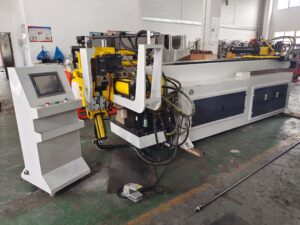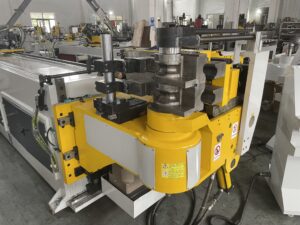What Is Cast Iron Pipe Cutter?
Understanding the Tool That Revolutionized Pipe Cutting in Plumbing and Construction
In the world of plumbing, construction, and industrial maintenance, cutting cast iron pipes has traditionally been one of the most labor-intensive and time-consuming tasks. However, with the advent of the cast iron pipe cutter, this task has become significantly more efficient, precise, and safer.
A cast iron pipe cutter is a specialized tool designed specifically for cutting through cast iron pipes used in drainage, waste, and vent systems.

1. Cast Iron Pipes
Cast iron pipes have been used in plumbing and drainage systems since the early 19th century.
However, as infrastructure ages, maintenance and replacement of these pipes become inevitable — and this is where cast iron pipe cutters come into play.
2. Why Cutting Cast Iron Pipes Requires Specialized Tools
Cast iron is a tough, brittle material. Unlike PVC or copper, it doesn’t respond well to traditional cutting tools like hacksaws or grinders. Attempting to cut cast iron with improper tools often results in:
- Cracked or shattered pipes
- Uneven cuts
- Increased safety hazards
- Time-consuming processes
To address these issues, engineers developed the cast iron pipe cutter, a tool specifically engineered to handle the rigidity and brittleness of cast iron without compromising the structural integrity of the surrounding components.
3. What Is a Cast Iron Pipe Cutter?
A cast iron pipe cutter is a mechanical or powered tool used to make clean, precise cuts through cast iron pipes. These cutters typically use a chain equipped with cutting wheels that wrap around the pipe. When tightened, the wheels apply pressure and progressively score the pipe until it snaps cleanly.
This method is not only effective but also minimizes the risk of pipe deformation and accidental damage, which is critical in confined spaces or when working with aging infrastructure.
4. Types of Cast Iron Pipe Cutters
There are several types of cast iron pipe cutters designed to meet different job requirements:
a. Chain Pipe Cutters
These are the most common and versatile. A chain with cutting wheels wraps around the pipe and, through tightening, scores and breaks the pipe.
b. Snap Cutters
Snap cutters are a type of chain cutter that “snap” the pipe after scoring. They are ideal for older cast iron that may be more brittle.
c. Hydraulic Pipe Cutters
These use hydraulic pressure to tighten the chain, making them suitable for larger diameter pipes or tougher materials.
5. How Does a Cast Iron Pipe Cutter Work?
The operation process may vary slightly depending on the model, but the core steps include:
- Wrap the chain around the pipe.
- Align the wheels at the cutting point.
- Tighten the chain using a handle or hydraulic mechanism.
- Apply pressure gradually until the pipe scores and snaps.
The result is a clean, even cut that requires minimal finishing.
6. Manual vs. Powered Cast Iron Pipe Cutters
Manual Cutters
- Pros: Cost-effective, simple to operate, no power source needed
- Cons: Labor-intensive, not ideal for large or thick pipes
Powered Cutters
- Pros: Fast, efficient, less strain on the worker
- Cons: Higher cost, requires battery or electric power source
Choosing between manual and powered cutters depends on your project scale, frequency of use, and budget.
7. Advantages of Using Cast Iron Pipe Cutters
- Precision Cutting: Clean, accurate cuts with minimal burrs
- Efficiency: Reduces labor time and physical effort
- Safety: Lower risk of accidental pipe breakage or injury
- Versatility: Suitable for different pipe diameters and wall thickness
- Portability: Especially with modern battery-operated models
8. Common Applications in Construction and Plumbing
Cast iron pipe cutters are used across a variety of industries:
- Residential Plumbing: Replacing or modifying old drainage systems
- Commercial Renovations: Upgrading infrastructure in aging buildings
- Municipal Projects: Sewer and stormwater pipe maintenance
- Industrial Facilities: Retrofitting or relocating piping systems
9. How to Choose the Right Cast Iron Pipe Cutter
When selecting a pipe cutter, consider the following:
- Pipe diameter: Ensure the cutter handles your pipe size
- Pipe thickness: Thicker pipes may require hydraulic or powered models
- Work environment: Confined spaces may require compact models
- Frequency of use: Occasional users may opt for manual cutters; regular users benefit from powered options
- Budget: Balance between cost and features
Top Brands to Consider: Reed, RIDGID, Wheeler-Rex, Milwaukee
10. Safety Tips When Using a Cast Iron Pipe Cutter
- Wear protective gear: Gloves, goggles, and long sleeves
- Inspect the tool before each use
- Secure the pipe to prevent movement
- Avoid over-tightening: Can cause accidental breakage
- Keep hands clear of moving parts
- Always follow manufacturer guidelines
11. Maintenance and Longevity of the Tool
Proper maintenance ensures your cast iron pipe cutter lasts for years:
- Clean after use
- Lubricate moving parts
- Check cutting wheels for wear and replace as needed
- Store in a dry place to prevent rust
With regular care, quality cutters can last over a decade in high-use environments.
12. Real-World Case Study: Cast Iron Pipe Replacement in a 50-Year-Old Building
Project Overview A mid-sized construction firm was contracted to renovate a 1960s-era apartment complex. The existing cast iron drainage system had begun to fail, causing leaks and water damage.
Challenge The pipes were located in narrow wall cavities, with limited space for maneuvering. Traditional cutting tools were ineffective and risked damaging surrounding structures.
Solution The team used a RIDGID 238-P powered cast iron pipe cutter, which allowed them to make clean cuts in confined spaces. The tool’s compact design and battery power enabled portability and reduced setup time.
Results
- 40% reduction in labor hours
- Zero pipe breakage incidents
- Clean, uniform cuts reduced time spent on rework
- Project completed 3 days ahead of schedule
Customer Feedback: “We couldn’t have finished this job on time without the cast iron pipe cutter. It was a game changer.” — Site Supervisor, Midtown Build Co.
13. FAQs About Cast Iron Pipe Cutters
Q: Can I use a cast iron pipe cutter on other materials? A: Some models may work on ductile iron or clay pipes, but for PVC or copper, use the appropriate cutter.
Q: Is it better to rent or buy a pipe cutter? A: For one-time or occasional use, renting is cost-effective. For professionals, buying saves money long-term.
Q: Are pipe cutters noisy? A: Manual cutters are relatively quiet. Powered cutters emit moderate noise but are less disruptive than grinders.
Q: Can I use an angle grinder instead? A: Technically yes, but grinders are less precise, messier, and pose greater safety risks.
14. Final Thoughts
In the ever-evolving fields of plumbing and construction, having the right tools can make the difference between a job well done and a costly mistake. The cast iron pipe cutter is a brilliant example of how specialized equipment can enhance productivity, safety, and precision.
As infrastructure continues to age, professionals who invest in understanding and using these tools will be better positioned to handle complex renovation and maintenance tasks efficiently.
Whether you’re a seasoned contractor or just starting out, mastering the use of a cast iron pipe cutter is a skill that will serve you well for years to come.



